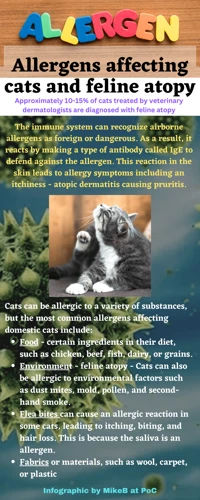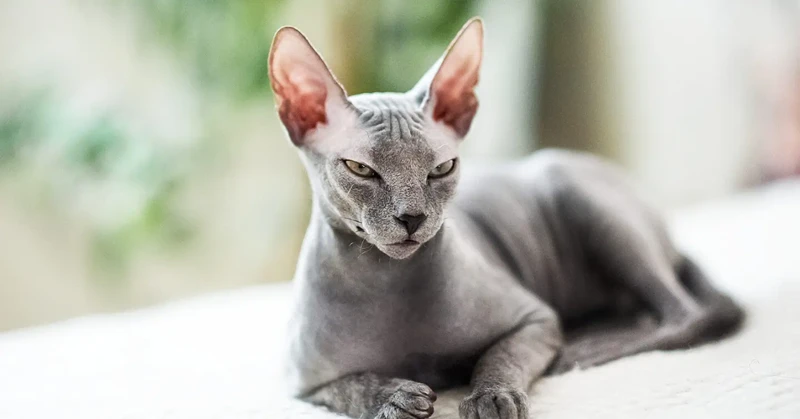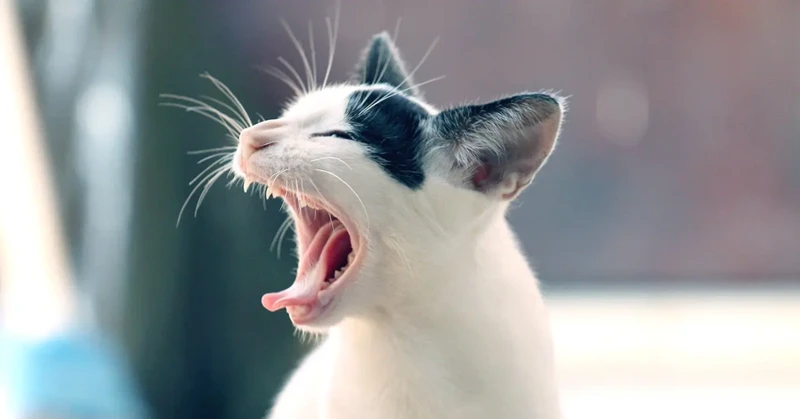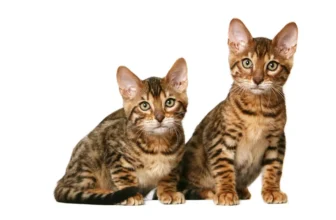If you are a California Spangled cat owner, you might have noticed some unusual behavior or symptoms in your feline. One common health issue that affects cats is allergies. Allergic reactions in California Spangled cats can cause a wide range of symptoms from itchy skin, sneezing, vomiting, and diarrhea. As a responsible pet owner, you need to know the causes, symptoms, and treatment options to manage your cat’s allergies. In this article, we will explore in detail the different causes of allergies in California Spangled cats, the symptoms to look out for, how to diagnose the allergies, treatment options, and how to prevent future allergic reactions.
Causes of Allergies in California Spangled Cats

Understanding the causes of allergies in California Spangled cats is crucial for providing proper care and treatment. While these cats are generally healthy and resilient, they can still be prone to allergies due to various reasons. Identifying the source of the allergy can help manage and prevent future allergic reactions. In this section, we will discuss the possible causes of allergies in California Spangled cats, including food, environmental, seasonal allergies, and insect bites and stings. If you want to learn more about how to keep your California Spangled cat healthy and happy, check out our article on Cali Spangled Vet Check-Ups.
Food Allergies
Food allergies can be a significant cause of allergies in California Spangled cats. According to studies, protein sources such as beef, chicken, fish and dairy products are common allergens in cats. That doesn’t mean your cat is allergic to these foods, but it’s good to be aware of the symptoms of food allergies.
If a California Spangled cat is allergic to certain foods, it can cause reactions such as gastrointestinal problems (vomiting and diarrhea), skin problems (itching, redness, and rashes), and ear infections. Additionally, food allergies may lead to more severe health problems, such as seborrhea, pruritus, and asthma in some cases.
It can be challenging to determine which specific ingredient in your cat’s food is causing an allergic reaction, but a few options can help you narrow it down. Owners can try keeping a food diary and jot down what your cat ate and the symptoms it experienced afterward. Elimination diets can also be beneficial when determining the source of food allergies.
It’s essential to be cautious when changing your cat’s diet. Switching foods abruptly can cause an upset stomach, refusal to eat, and other gastrointestinal problems. Pet owners should transition their cat’s diet gradually over several days or even weeks by mixing in small amounts of the new food with the old food.
If you’re unsure about what to feed your California Spangled cat, consult with a veterinarian or a pet nutritionist. They can recommend an appropriate diet plan that will provide all of the necessary nutrients your cat needs to maintain good health.
To sum up, recognizing the signs of food allergies in your California Spangled cat is crucial. By avoiding potential allergens, feeding your cat a balanced diet, and regularly monitoring its symptoms, you can keep your feline friend healthy and happy.
Environmental Allergies
California Spangled cats can also develop environmental allergies, which are caused by exposure to environmental elements such as dust mites, pollen, mold, and smoke. These allergens can be inhaled by your cat, come into contact with their fur, or be ingested if they groom themselves after coming into contact with them.
Symptoms of environmental allergies in California Spangled cats can include scratching, licking, and chewing on their fur, which can lead to hair loss and open sores. Other symptoms may include coughing, sneezing, and watery eyes. Chronic exposure to certain types of allergens can also lead to asthma in cats.
To manage environmental allergies in your California Spangled cat, you can take steps to reduce their exposure to the allergens. One way to do this is to keep your home clean and free of dust and mold. You should also consider investing in an air purifier to filter out any airborne allergens.
Regularly bathing your California Spangled cat can also help reduce their exposure to allergens. Use a gentle, hypoallergenic shampoo and make sure to rinse thoroughly. Additionally, you can try wiping down your cat’s fur with a damp cloth to remove any allergens they may have come into contact with.
If your California Spangled cat is displaying symptoms of environmental allergies, it is important to take them to the vet for diagnosis and treatment. The vet may recommend antihistamines or steroids to alleviate your cat’s symptoms. They may also conduct allergy testing to identify the specific allergens your cat is reacting to.
Internal link: For more health tips for California Spangled cats, check out our article on health tips.
Seasonal Allergies
Seasonal allergies are a common problem among California Spangled cats. These allergies occur when the cat’s immune system overreacts to pollen or other outdoor allergens that are more prevalent during certain times of the year, such as spring or late summer.
Symptoms of seasonal allergies in California Spangled Cats
During allergy season, California Spangled cats may exhibit a range of symptoms such as sneezing, coughing, and runny nose. They may also experience itchy, watery eyes, and develop skin irritations, such as hives or rashes.
To further exacerbate the issue, affected cats may also experience digestive issues like vomiting and diarrhea. As a result, they may experience decreased appetite or even refuse to eat.
Treatment for seasonal allergies in California Spangled Cats
Fortunately, there are ways to treat seasonal allergies in California Spangled cats. Antihistamines, allergy shots, and corticosteroids may help alleviate symptoms, but as with any medication, it’s essential to consult with a veterinarian before administering.
Allergy shots, also known as immunotherapy, aim to lessen the cat’s allergic reaction to specific allergens by introducing small doses of the allergen to their system continually. It involves multiple injections over a period of time, but it can be effective in minimizing the severity of allergy symptoms.
Preventative measures for seasonal allergies in California Spangled Cats
While it’s impossible to completely eliminate outdoor allergens, There are measures to prevent and deal with seasonal allergies in California Spangled cats. Here are some measures you can take to protect your cat:
| Preventative Measures for Seasonal Allergies in California Spangled Cats: |
|---|
| Avoid outdoor activities during peak pollen seasons |
| Bathe your cat regularly to remove any allergens from their coat |
| Keep your cat indoors during high pollen count or windy weather days |
| Use air filters and regularly clean any ventilation systems to reduce indoor allergen concentration |
| Provide high-quality, nutritious food to boost your cat’s immune system |
By following these preventative measures, you can minimize the effects of seasonal allergies in California Spangled cats. Additionally, purchasing pet healthcare plans for California Spangled cats and regular checkups with your vet can also ensure that your cat’s health and well-being is maintained optimally.
Insect Bites and Stings
Insect bites and stings can also trigger allergies in California Spangled Cats. Most insect bites and stings cause mild reactions, but in some cases, they can cause severe allergic reactions. An allergic reaction to an insect bite or sting can be life-threatening.
Here are some symptoms of allergic reactions to insect bites and stings in California Spangled Cats:
- Hives: These are raised, itchy bumps on the skin.
- Swelling: The cat’s face, lips, tongue, or throat may swell, making it difficult for them to breathe.
- Difficulty breathing: Your cat may appear to be struggling to breathe due to the swelling.
- Vomiting and diarrhea: Allergies can also cause vomiting and diarrhea in cats.
- Weakness or collapse: This is a severe life-threatening reaction and requires immediate veterinary assistance.
If you spot any of these symptoms in your California Spangled Cat after an insect bite or sting, take them to the vet immediately. The vet may recommend medication or immunotherapy to alleviate symptoms in cats with insect allergies.
It is essential to keep your California Spangled Cat away from insects as much as possible to prevent insect bites and stings. You can do this by keeping your cat indoors or keeping an eye on them during outdoor play time. If your cat is struggling with insect allergies, you may want to consider discussing different healthcare plans with your veterinarian to ensure your cat receives the best care possible.
If your California Spangled Cat is in good health, you may also want to consider adding vitamins and minerals to their diet to boost their immune system further. T5 vitamins and minerals are great supplements to help prevent allergic reactions and keep your cat healthy. Additionally, spaying or neutering your cat and providing regular dental care can also help prevent allergic reactions and other health issues.
Symptoms of Allergies in California Spangled Cats

If your California Spangled cat is exhibiting unusual behavior or symptoms, it could be a sign of allergies. Allergies in cats can have a variety of symptoms that can be confusing to interpret. Symptoms of allergies in California Spangled cats can range from mild skin irritations to respiratory distress. Identifying these symptoms can help you seek help from a veterinarian and start treatment as soon as possible.
Skin Irritation and Itching
Skin Irritation and Itching are common symptoms of allergies in California Spangled cats. When a cat’s immune system overreacts to an allergen, it can cause skin irritation and itching. It is important to identify the underlying cause of the allergy to provide the appropriate treatment.
Symptoms: Skin irritation and itching cause discomfort and can lead to secondary skin infections. Symptoms of skin irritation and itching in cats include:
- Scratching or licking the affected area
- Redness or inflammation of the skin
- Scabbing or crusting of the skin
- Hot spots or areas of hair loss
- Changes in skin texture or thickness
Some of the common allergens that can cause skin irritation and itching in California Spangled cats include:
| Allergen | Description |
|---|---|
| Fleas | Flea bites can cause an allergic reaction in cats, leading to severe itching and skin irritation. |
| Dust Mites | Dust mites are found in bedding, carpets, and furniture. When inhaled, they can trigger allergies and lead to skin irritation and itching. |
| Pollen | Pollen from trees, grasses, and weeds can cause seasonal allergies in cats, leading to skin irritation and itching. |
| Mold | Mold spores can trigger allergies and cause skin irritation and itching in cats. |
| Food | Certain food proteins can trigger allergic reactions in cats, causing skin irritation and itching. Common allergenic ingredients include beef, wheat, and dairy products. |
To relieve skin irritation and itching in California Spangled cats, the underlying cause must be identified and treated. Your veterinarian may recommend:
- Medication such as antihistamines, steroids, or antibiotics to relieve symptoms and prevent secondary infections.
- Immunotherapy to desensitize your cat’s immune system to the allergens causing the allergy.
- Natural remedies such as oatmeal baths, aloe vera, and coconut oil can also provide relief for mild cases of skin irritation and itching.
It is important to maintain good hygiene and take preventive measures to manage skin irritation and itching in California Spangled cats. Regular flea control and dental care can help prevent allergies caused by fleas and bacteria in your cat’s mouth. A balanced diet rich in essential nutrients can also help boost your cat’s immune system and prevent allergic reactions.
Skin irritation and itching are common symptoms of allergies in California Spangled cats. Identifying and treating the underlying cause of the allergy is crucial to providing relief for your cat. With proper treatment, good hygiene, and preventive measures, you can help your cat live a happy and healthy life.
Sneezing and Runny Nose
Sneezing and runny nose are common symptoms of allergies in California Spangled cats. These symptoms can be caused by various allergens, including pollen, dust mites, and mold. When a cat inhales or comes into contact with an allergen, their immune system reacts by producing histamines, which can cause the nasal tissues to become inflamed and produce excessive mucus. This can lead to sneezing and a runny nose.
It is important to note that sneezing and runny nose can also be symptoms of other health issues, such as respiratory infections or feline herpes virus. If your California Spangled cat is experiencing persistent sneezing and a runny nose, it is important to take them to the vet for a proper diagnosis.
If allergies are the cause of your cat’s symptoms, your vet may recommend medications such as antihistamines or steroids to help alleviate their symptoms. It is important to never administer over-the-counter medications to your cat without consulting with your vet first, as some medications can be toxic to cats.
In addition to medication, there are also some natural home remedies that can help alleviate your cat’s sneezing and runny nose. One such remedy is steam therapy, where you can use a humidifier or take your cat into a steamy bathroom to help ease their congestion. It is important to never leave your cat unattended in the bathroom, as the moist environment can pose a risk to their safety.
Another way to alleviate your California Spangled cat’s sneezing and runny nose is to keep their environment clean and free of allergens. Regularly vacuuming, dusting, and washing their bedding can help reduce exposure to common allergens like dust mites and pollen.
Sneezing and runny nose are common symptoms of allergies in California Spangled cats. If your cat is experiencing these symptoms, it is important to consult with your vet to determine the underlying cause and develop an appropriate treatment plan.
Vomiting and Diarrhea
Vomiting and diarrhea are common symptoms of allergies in California Spangled Cats. They can be caused by a reaction to certain foods or exposure to allergens in the environment. If your cat is experiencing vomiting or diarrhea, it is important to pay attention to the frequency and consistency of these symptoms.
Vomiting: If your California Spangled Cat is vomiting frequently, it could be a sign of an allergic reaction to a food or environmental allergen. Other possible causes of vomiting include a gastrointestinal infection or an underlying medical condition. If the vomiting persists and your cat becomes dehydrated, you should seek veterinary care immediately.
Diarrhea: Diarrhea can be a common symptom of allergies in California Spangled Cats. It may be caused by consuming a trigger food or inhaling an allergen. In some cases, diarrhea can lead to dehydration, which can be dangerous for cats. If your cat is experiencing diarrhea, it is important to monitor their fluid intake and seek veterinary care if the diarrhea continues for more than 24 hours.
To help relieve vomiting and diarrhea symptoms, it is important to identify and eliminate the allergen triggers. Your vet may also suggest a dietary change or provide medication to ease these symptoms.
Additionally, spaying or neutering your California Spangled Cat can also help prevent certain allergies and other health issues. To learn more about the benefits of spaying and neutering your cat, check out our article on Cali Spangled Cat spaying and neutering.
Ear Infections
Ear infections are another common symptom of allergies in California Spangled Cats that you should keep an eye out for. Some cats may develop ear infections because of allergies to certain foods or environmental factors. However, ear infections can also be a sign of other medical conditions, so it’s important to have your cat examined by a veterinarian if you notice any symptoms.
Symptoms: Ear infections can cause a range of symptoms, including:
| Symptoms of Ear Infections in California Spangled Cats |
|---|
| Scratching or rubbing at the ears |
| Brown or yellow discharge from the ears |
| Odor coming from the ears |
| Redness or swelling of the ear canal |
| Head shaking or tilting |
If your cat is exhibiting any of these symptoms, it’s important to bring them in for a physical examination. Your vet may recommend taking a sample of ear discharge to determine the underlying cause of the infection.
Treatment: Treatment for ear infections in California Spangled Cats typically involves cleaning the ears and administering medication to clear up any infections. Your vet may also recommend making changes to your cat’s diet or environment to prevent future ear infections.
It’s important to follow your vet’s instructions closely and continue to monitor your cat for any signs of recurring ear infections. With proper treatment and management, you can help your cat live a comfortable, allergy-free life.
Diagnosing Allergies in California Spangled Cats

When it comes to diagnosing allergies in California Spangled cats, pet owners often face confusion and uncertainty. Identifying the allergen causing discomfort to your feline friend can be a tricky task, as the symptoms of allergies mimic those of other illnesses. However, with a proper diagnosis, you can take appropriate measures to manage your cat’s allergies. In this section, we’ll discuss the different methods used by veterinarians to diagnose allergies in California Spangled cats, including physical examinations, allergy tests, and elimination diets.
Physical Examination
During a physical examination, a veterinarian will carefully examine your California Spangled cat’s overall health and check for any signs of allergies. This examination may include:
- Skin examination: The vet will check for any signs of skin irritation or rashes, which can indicate a food or environmental allergy.
- Ear examination: Allergies can cause ear infections, so the vet will check the inside of your cat’s ears for any signs of inflammation, redness, or discharge.
- Respiratory examination: The vet will listen to your cat’s breathing to check for any signs of wheezing, coughing, or labored breathing, which can be symptoms of allergies.
- Eye examination: Allergies can cause redness, itching, and discharge from the eyes, so the vet will examine your cat’s eyes for any signs of allergies.
- Overall health check: The vet will perform a general checkup to ensure that there are no underlying health issues that could be contributing to your cat’s allergies.
It’s essential to provide your veterinarian with a complete medical history of your cat, including any prior medication or treatment. This information can help the vet to diagnose and treat any allergies your cat may be experiencing more effectively. By conducting a physical examination, your veterinarian can determine the cause of your cat’s allergies and suggest the best course of treatment.
Allergy Tests
Allergy testing is the process of determining the specific allergen responsible for causing allergies in California Spangled cats. This can be done through various tests performed by a veterinarian. The results of these tests will help the veterinarian develop an effective treatment plan for your cat.
Skin Test: In this test, a small amount of allergen is injected into the skin of the cat, and the reaction is observed. The skin test can help identify multiple allergens.
Blood Test: In a blood test, the veterinarian will examine a sample of your cat’s blood to look for specific antibodies that indicate an allergic reaction. This test can also help identify multiple allergens.
Elimination Diet: An elimination diet involves removing common foods that cause allergies one by one from the cat’s diet and replacing them with an alternate source. This process can help identify food allergens.
Before undergoing any allergy test, it is important to discuss with your veterinarian any medications your cat might be taking, as some medications can interfere with the results of the test. Additionally, the veterinarian will likely recommend discontinuing any antihistamines for a period of time before the test, as these medications can also affect the results.
Once the specific allergen is identified through allergy tests, your veterinarian may create a plan for desensitizing your cat to the allergen. This can be done through immunotherapy, a treatment that gradually exposes the cat to the allergen in a controlled manner with the goal of building up immunity. It is crucial to follow your veterinarian’s treatment plan and continue to communicate any symptoms your cat experiences.
Elimination Diet
An elimination diet can be an effective way to determine whether a California Spangled cat is suffering from food allergies. The process involves removing all potential allergens from the cat’s diet and then reintroducing them one by one to determine which ones trigger a reaction. This approach may take several weeks or even months and requires strict adherence to the recommended diet.
How to Implement an Elimination Diet for Your Cat
To implement an elimination diet effectively, you will need to work closely with your veterinarian. An elimination diet typically involves the following steps:
1. Identify potential allergens: Common allergens in cat food include chicken, beef, dairy products, and grains like wheat and corn.
2. Switch to a novel protein diet: A diet consisting of a novel protein source like rabbit or venison should be used during the elimination period.
3. Avoid treats and table scraps: Your cat should only be fed the novel protein diet, no other types of food or treats should be offered.
4. Monitor your cat’s symptoms: Watch for any signs of improvement in your cat’s condition during the elimination period.
5. Reintroduce potential allergens: After a period of 8-12 weeks, potential allergens can gradually be reintroduced one by one every two weeks to see if any symptoms return.
6. Monitor your cat’s reaction: Keep a close eye on your cat’s reaction to each food item as they are reintroduced. If your cat shows any signs of allergies, remove the suspected allergen from their diet.
Benefits of an Elimination Diet for Your Cat
Implementing an elimination diet for your California Spangled cat can be beneficial for several reasons. One major benefit is that you will be able to identify which specific foods or ingredients are causing your cat’s allergies. This information will allow you to make changes to your cat’s diet that will help to alleviate their symptoms.
Conclusion
If you suspect that your California Spangled cat may be suffering from food allergies, an elimination diet may be a useful tool to identify the specific allergen. However, it is important to work closely with your veterinarian throughout the process to ensure that it is done correctly and safely.
Treatment Options for Allergies in California Spangled Cats

When your California Spangled cat is experiencing allergies, it can be tough to see them suffer. Fortunately, there are several treatment options available to soothe their symptoms and help them feel better. From medications to immunotherapy and home remedies, there are plenty of avenues to explore. Let’s take a closer look at some of the options available to you and your feline friend.
Medication
Treating allergies in California Spangled Cats often involves the use of medication prescribed by a veterinarian. The right medication will depend on the specific allergy and its severity. Here are some options for medication:
| Medication Type | Description | Common Brands |
|---|---|---|
| Antihistamines | Block histamine receptors to reduce symptoms like itching and sneezing | Benadryl, Claritin, Zyrtec |
| Corticosteroids | Reduce inflammation and allergic reactions throughout the body | Prednisone, Triamcinolone, Dexamethasone |
| Immunosuppressants | Suppress the immune system to lessen the severity of allergic reactions | Cyclosporine, Azathioprine |
| Topical Creams & Ointments | Relieve skin irritation and itching | Hydrocortisone, Tacrolimus, Mometasone |
| Bronchodilators | Open airways in the lungs to relieve breathing difficulties caused by allergic reactions | Albuterol, Aminophylline |
It’s important to note that medication should only be used under the guidance of a veterinarian, as some medications may have side effects or be ineffective depending on the individual cat’s health and allergy situation. Additionally, medication should only be part of a comprehensive treatment plan that addresses all aspects of the cat’s allergies, including prevention and management.
Immunotherapy
Immunotherapy is a treatment option that involves the administration of allergens to a California Spangled cat in increasing doses over a period of time. The goal of immunotherapy is to desensitize the cat’s immune system to the allergens that trigger an allergic reaction.
The process of immunotherapy typically involves the following steps:
- Allergy testing: First, your veterinarian will perform allergy testing to identify the specific allergens that your cat is allergic to. This can be done through a skin test or a blood test.
- Customized treatment plan: Based on the results of the allergy testing, your veterinarian will develop a customized treatment plan for your cat. This may include the use of allergy shots, sublingual drops, or a combination of both.
- Gradual desensitization: Your cat will receive increasing doses of the allergen over time, typically starting with a very low dose and gradually increasing to a higher level. The goal is to desensitize your cat’s immune system to the allergen, so that it no longer triggers an allergic reaction.
- Monitoring: Your cat will be closely monitored during the treatment process to ensure that it is responding well to the therapy and to adjust the dosage as needed.
Benefits of Immunotherapy
Immunotherapy has several benefits for cats with allergies, including:
- Effective: Immunotherapy is a very effective treatment for many cats with allergies, and can significantly improve their quality of life.
- Long-lasting: The benefits of immunotherapy can last for many years, even after the treatment has been completed.
- No side effects: Unlike some medications, immunotherapy does not typically cause any side effects, making it a safe option for many California Spangled cats with allergies.
However, it is important to note that immunotherapy is not always effective for all cats with allergies. Your veterinarian will be able to determine if this treatment option is appropriate for your California Spangled cat based on their individual allergy symptoms and medical history.
Home Remedies
When it comes to treating allergies in California Spangled Cats, some pet owners prefer to use home remedies as a natural alternative to medication or immunotherapy. However, it is important to remember that not all home remedies are safe or effective for cats. Here are some home remedies that can be helpful for managing allergies in California Spangled Cats:
| Home Remedy | Description |
|---|---|
| Apple Cider Vinegar | Apple cider vinegar can help to reduce itching and inflammation caused by allergies. Dilute one part apple cider vinegar with two parts water and apply to your cat’s skin using a spray bottle or a cotton ball. Do not apply to broken or irritated skin. |
| Coconut Oil | Coconut oil can help to soothe dry, itchy skin and can be ingested to promote a healthy immune system. Add a small amount of coconut oil to your cat’s food or apply a small amount to their skin. However, too much coconut oil can cause diarrhea, so use in moderation. |
| Quercetin | Quercetin is a natural antihistamine that can help to reduce inflammation and itching caused by allergies. You can find quercetin supplements at your local health food store or online. However, talk to your veterinarian before giving your cat any supplements. |
| Borage Oil | Borage oil can help to reduce itching and inflammation caused by allergies. You can find borage oil supplements at your local health food store or online. However, talk to your veterinarian before giving your cat any supplements. |
| Omega-3 Fatty Acids | Omega-3 fatty acids can help to reduce inflammation and promote healthy skin and hair. You can add omega-3 supplements to your cat’s food or feed them foods that are high in omega-3s, such as salmon or sardines. |
It is important to note that while these home remedies can be helpful in managing allergies in California Spangled Cats, they should not replace professional veterinary care. If your cat is experiencing severe symptoms or if their allergies are not improving with home remedies, it is important to seek medical attention from a veterinarian.
Prevention and Management of Allergies in California Spangled Cats
As a California Spangled cat owner, preventing and managing allergies is crucial for the overall health and wellbeing of your feline friend. While allergies cannot always be completely cured, taking steps to minimize exposure to allergens and keeping your cat healthy can greatly reduce the severity of allergic reactions. In this section, we will explore some measures you can take to prevent and manage allergies in your California Spangled cat. From identifying and avoiding allergens to providing proper nutrition, read on to discover how you can help your furry companion live a healthy and allergy-free life.
Identify and Avoid Allergens
When dealing with allergies in California Spangled cats, it is crucial to identify and avoid the specific allergens that trigger their symptoms. This can be a challenging task, as there are various potential allergens that cats can react to. However, identifying the allergen and avoiding contact with it can significantly improve your cat’s health and quality of life.
Common Allergens for California Spangled Cats
Some common allergens for California Spangled cats include dust mites, pollen, mold, and certain types of food. In addition to these, some cats may also develop an allergy to flea bites, which can be prevented by regular flea control treatments.
Identifying Allergens in Your Home
To identify potential allergens in your home, you can use an allergen test kit, which measures the amount of allergens in the air or on surfaces. You can also observe your cat and note any changes in behavior or symptoms after exposure to certain substances or situations.
Once you have identified the specific allergen, it is crucial to avoid contact with it as much as possible. This may involve making changes to your cat’s environment or routine to minimize exposure to the allergen.
Avoiding Allergens in Your Home
Here are some strategies you can use to avoid allergens in your home:
| Strategy | Description |
|---|---|
| 1. Use an air purifier | An air purifier can help remove allergens from the air and improve the air quality in your home. |
| 2. Wash bedding and toys regularly | Regularly washing your cat’s bedding and toys can help remove allergens and prevent their buildup. |
| 3. Vacuum and dust frequently | Vacuuming and dusting your home frequently can help remove allergens from surfaces and the air. |
| 4. Avoid smoking indoors | Cigarette smoke can worsen allergies in both cats and humans, so it is important to avoid smoking indoors. |
| 5. Use hypoallergenic products | Using hypoallergenic products for cleaning, grooming, and feeding can help reduce the risk of triggering allergies in your cat. |
Conclusion
Identifying and avoiding allergens is essential for managing allergies in California Spangled cats. By taking steps to avoid contact with specific allergens, you can improve your cat’s health and prevent future allergic reactions. Regular cleaning, use of air purifiers, and hypoallergenic products can all help to minimize allergen exposure and protect your cat’s well-being.
Clean and Maintain Your Home
Keeping your home clean and well-maintained is crucial in preventing and managing allergies in California Spangled cats. Regular cleaning and maintenance can help remove allergens from your cat’s environment and reduce their exposure to potential triggers. Here are some essential tips to follow:
| Tip | Description |
|---|---|
| Use hypoallergenic products | Choose cleaning products that are gentle and free from harsh chemicals or fragrances. Consider using natural alternatives or products specifically labeled as hypoallergenic to reduce the risk of allergic reactions. |
| Vacuum frequently | Regularly vacuum your carpets, rugs, and furniture to remove dust, pet hair, and other allergens that may accumulate. Use a vacuum with a HEPA filter to capture the smallest particles that can trigger allergies. |
| Wash bedding and linens regularly | Wash your cat’s bedding and your own linens in hot water once a week to remove dust mites, pollen, and other irritants. Use fragrance-free laundry detergent to avoid any allergic reactions. |
| Clean litter boxes daily | Clean your cat’s litter boxes daily to prevent the buildup of waste and harmful bacteria that can trigger allergies. Consider using unscented litter and keeping the litter box in a well-ventilated area to minimize odors and dust. |
| Avoid smoking indoors | Smoking indoors can introduce harmful chemicals and irritants into the air, worsening your cat’s allergies. Make sure to avoid smoking inside your home or around your cat. |
| Keep your home dry | Humidity can promote the growth of mold and mildew, which can trigger allergies. Use dehumidifiers or air conditioners to keep your home dry and prevent the buildup of moisture. |
By following these simple tips and keeping your home clean and well-maintained, you can reduce your California Spangled cat’s exposure to potential allergens and help manage their allergies effectively. Remember, prevention is key when it comes to managing and treating allergies in cats.
Provide Nutritious Food
A nutritious diet is essential for maintaining the overall health of California Spangled Cats and it can also play a significant role in managing allergies. Feeding your cat a balanced and nutrient-rich diet can strengthen the immune system, which can help deal with allergies in a more effective manner. Here are some tips to help you provide nutritious food for your beloved feline friend:
| Tips for providing nutritious food for your California Spangled Cat |
|---|
| 1. Choose high-quality cat food: Look for brands that use high-quality, whole-food ingredients and avoid those that contain artificial colors, preservatives, and fillers. |
| 2. Avoid common allergens: Identify any allergens that your cat may be sensitive to and avoid them when choosing cat food. Common allergens such as grains, dairy, and chicken may need to be excluded from your cat’s diet. |
| 3. Include Omega-3 fatty acids: Omega-3 fatty acids are known for their anti-inflammatory properties which can help reduce the severity of allergic reactions and skin irritations. Fish-based cat food or adding a fish oil supplement to their diet can be beneficial. |
| 4. Provide fresh, clean water: Cats need access to clean water at all times. Make sure to change their water daily and consider investing in a water fountain that will keep water flowing and fresh. |
| 5. Consider a homemade diet: Preparing homemade cat food can give you complete control over the ingredients and can be helpful in eliminating allergens from your cat’s diet. However, it’s important to consult with a veterinarian or a veterinary nutritionist to ensure that the diet is balanced and meets your cat’s nutritional needs. |
By following these tips, you can provide your California Spangled Cat with a nutritious diet that can improve their overall health and help them better deal with allergies. It’s important to note that any dietary changes should be made gradually and under the guidance of a veterinarian to ensure that your cat’s nutritional needs are met.
Conclusion
In conclusion, dealing with allergies in California Spangled Cats can be a challenging and frustrating experience, but with proper management and treatment, it can be effectively controlled. It is crucial to identify the causes and symptoms of allergies in California Spangled Cats and seek veterinary advice as soon as possible.
Prevention and management play a critical role in reducing the occurrence and severity of allergies in California Spangled Cats. Identifying and avoiding allergens is key to managing allergies. It is also essential to maintain a clean home and provide nutritious food to strengthen the immune system.
Treatment options for allergies in California Spangled Cats range from medication to immunotherapy and home remedies. Medications such as antihistamines, corticosteroids, and allergy shots can help control symptoms and prevent severe allergic reactions.
Home remedies such as natural supplements, bathing, and grooming can also help alleviate allergies.
The diagnosing process may involve a physical examination, allergy tests, and an elimination diet to identify specific allergens.
Overall, with proper care and management, California Spangled Cats with allergies can lead happy and healthy lives. As a cat owner, it is essential to educate yourself about the causes, symptoms, and treatment options for allergies in California Spangled Cats and work closely with your veterinarian to develop an effective management plan for your furry friend.
Frequently Asked Questions
What are some common food allergens for California Spangled Cats?
Some common food allergens for California Spangled Cats include chicken, beef, fish, dairy products, and grains such as wheat and corn.
Can California Spangled Cats develop allergies to their litter?
Yes, some California Spangled Cats can develop allergies to their litter, especially if it contains fragrances or other additives.
What are some common environmental allergens for California Spangled Cats?
Common environmental allergens for California Spangled Cats include pollen, dust mites, mold spores, and cigarette smoke.
How can I tell if my California Spangled Cat is experiencing an allergic reaction?
Signs of an allergic reaction in a California Spangled Cat may include skin irritation and itching, sneezing, vomiting or diarrhea, and ear infections.
Can California Spangled Cats receive allergy tests?
Yes, allergy tests are available for California Spangled Cats and can involve either a blood test or a skin test.
What is the best way to treat allergies in California Spangled Cats?
The best way to treat allergies in California Spangled Cats depends on the specific allergy and its severity. Treatment options may include medication, immunotherapy, or home remedies.
Should I try a elimination diet if I suspect my California Spangled Cat has a food allergy?
Yes, an elimination diet can be a helpful way to pinpoint specific food allergens in California Spangled Cats.
What are some home remedies that may help alleviate allergy symptoms in California Spangled Cats?
Home remedies for California Spangled Cat allergies may include bathing with oatmeal shampoo, offering supplements such as fish oil or probiotics, and using a HEPA air purifier in the home.
Can California Spangled Cats outgrow allergies?
While some allergies in California Spangled Cats may improve or disappear with time, others may persist throughout their lifetime.
What can I do to prevent allergies in my California Spangled Cat?
You can help prevent allergies in your California Spangled Cat by identifying and avoiding allergens, regularly cleaning and maintaining your home, and providing a nutritious diet.







